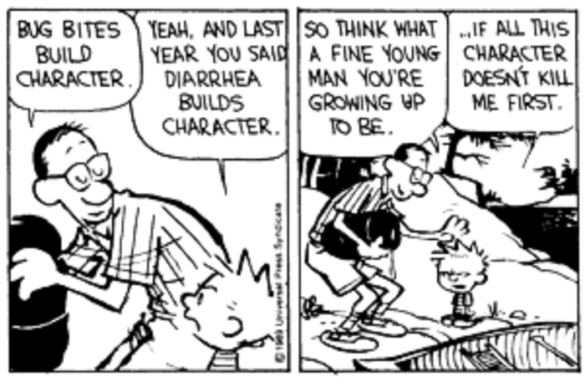We recently shared part one of Practical strategies for raising positive and resilient kids and would recommend that if you haven’t read that article yet you start there first. It covered how to help kids focus on and stay in control, ways to help offer them a better perspective and ideas for using gratitude that construct an appreciation for what they already have.
Next up, we have four more useful ideas for helping your child see the bright side and quickly bounce back from hardships that might come their way.
Try negative visualisation
Imagining bad things happening to us might seem like a weird route to becoming more positive, but this is precisely how “negative visualization” works.
Irvine describes it as “the process in which you give yourself a few seconds to imagine that the thing you value somehow disappears from your life.”
To practice negative visualisation with your children, you can ask them to list a few things in their life that they love, or are really happy to have. They may say their toys, their pets, their Nintendo…whatever it is, you then ask them to imagine for just a few seconds, that these things are gone, and what that would feel like. What would they do without them? What would that life look like? The mere process of contemplating life with the absence of things they love will have benefits that are twofold.
Firstly, it will help them not to take the things they love for granted. Moreover, it will help them feel a little more prepared for if this event actually does occur.
“Children learn to visualize what might go wrong in a situation, imagine the details of the possible negative outcome, and shift their attention to facts rather than random worrisome speculations. They visualize a contingency plan. They engage in adversity training through visualization.” Professor Patty O’Grady Ph.D., Psychology Today.
So next time your children are fighting over which game they will play, try a quick negative visualisation of what life without any games would look like!
Teach them about transience
All things are impermanent, but many children don’t know it yet. A real silver lining here is that we can assure our kids that no matter how deep a pain feels, it won’t last forever.
In reality, all things are temporary, there will be a last time for everything we do and this is a concept that we should teach our children. You can use this knowledge to help your child grasp things they should be grateful for in the present.
For example, if your kids are reluctant to go outside on the swings, you can remind them that one day they’ll be too big to fit on the swings, and they will look back on these days fondly, wishing they had spent more time on them.
The “Last time” technique, Irvine speaks of, fosters gratefulness now by playing on the idea that we may go on to regret the things we don’t do. Often, thinking about doing something as if it were the last time can make us approach it differently.
Talking to kids about transience also teaches them to expect constant change as a natural part of life. In this way, it prepares them to accept (rather than fear) change the next time that it rears its head.

Weaponise laughter
Kids can be cruel, but you can use the insights of Stoicism to help them handle receiving insults in a way that won’t damage them.
“After considering ways to respond to insults, the Stoics came out in favour of what might be called “insult pacifism”: we should try never to inflict first-strike insults, and when we have been insulted, we should respond not with a counter-insult, but with silence or self-deprecating humour.” William Irvine, Huffpost.
Accordingly, you should advise your children that to receive an insult and emerge, not only unscathed, but potentially with the upper hand they should do the following:
First, ignore the insult and act as if nothing was said. If the speaker repeats the insult they should then say “I know, I heard you the first time.” and laugh it off.
Another option (that may only suit older kids) is for them to insult themselves in a self-deprecating way even worse than the other person did, whilst laughing.
“When you respond to people’s insults not with counter‑insults but with humour, you make them look foolish: they hit you with their best verbal shot, and you only laughed in response. As a result, they are less likely to insult you again. I have also discovered that by responding to insults with self‑deprecating humour, you take much of the sting out of them. This is because it is psychologically difficult to get upset over something you are making a joke about.” William Irvine, TIME Magazine.
Teach your child that if they are able to remain calm and act unphased (despite how angry they may be feeling) then the bully has failed to get the reaction they sought, looks silly and loses their power. When we don’t participate in their power play, we are also less likely to be damaged by their words.
Gamify curveballs
Stoicism reframes setbacks as challenges from “the gods”. The idea is that challenges (like pandemics, floods etc) are sent our way to strengthen us, as only by facing adversity and living through it can we become stronger.
You can be like Calvin’s Dad, and simplify the issue by telling your children that anything difficult “builds character” or you can implore them to view such difficulties as another level in the game of life, that must be defeated if we are to win.

Irvine suggests that you may even like to go on “Stoic adventures” where you plan to face obstacles and then assess yourself on whether you were able to keep control of your emotions when you met the obstacle and also whether you found a successful solution to overcoming it.
As a parent, you can even stage “Stoic adventures” like bushwalks or road trips where you get “lost” but everyone helps find their way back so that you can simulate challenges for your children, which you know you can confidently solve.
Importantly, however, don’t solve any challenge too quickly or easily as it may seem intimidating and out-of-reach for our kids.
“Our children are novices in emotion regulation; they learn best when we model healthy emotion regulation that isn’t too perfected, that starts out looking similar to their own experience but then takes a slightly different path.” describes Clinical Child Psychologist Becky Kennedy in this useful article on modelling realistic regulation.
She also provides a handful of excellent scripts for keeping kids calm whilst facing challenges.

Key Takeaways
To recap, here is a simplified version of the practical strategies you can use to help your children be positive and resilient:
- Focus on what you can control, namely your values and choices and use them to construct their next step.
- Discover a new perspective by pondering how your situation could be much worse.
- Find what you are grateful for each day, share it and write it down when you can.
- Imagine worse case scenarios and what you’d do in them as a form of preparation.
- Ignore, laugh off, or exaggerate insults to comic effect.
- Make a game out of stepping up to challenges.
We hope you find these strategies useful in your day-to-day parenting. Check out our blog for even more helpful parenting tips.

